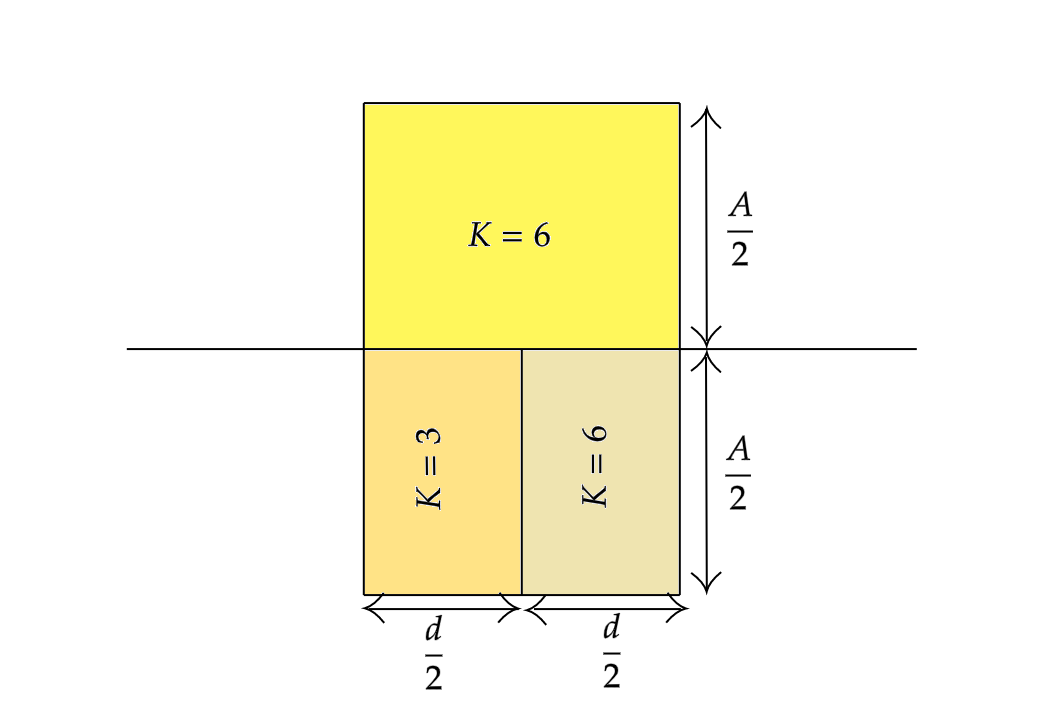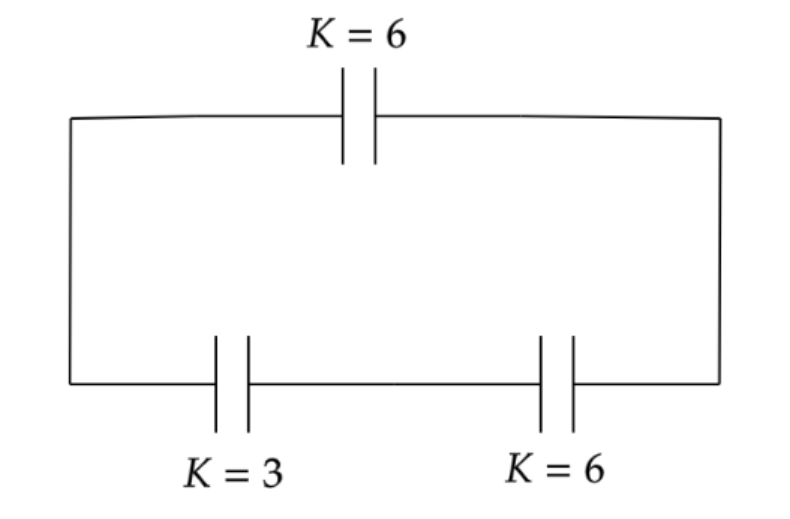
Three different dielectrics are filled in a parallel plate capacitor as shown. What should be the dielectric constant of a material, which when fully filled between the plates produces the same capacitance?

$ \left( A \right)4 $
$ \left( B \right)6 $
$ \left( C \right)5 $
$ \left( D \right)9 $

Answer
480.3k+ views
Hint: Whenever a dielectric is inserted between a parallel plate of a capacitor then the new value of the capacitor increases by k time the original capacitor. And if more than one dietetic material is inserted in between the parallel plated then each medium will act as a separate capacitor. Now using this concept first convert each dielectric into a separate capacitor so as to analyze their connection that they are in series or parallel. Now find the equivalent capacitor of the three dielectric materials and equate it with the original capacitance.
Complete answer:
We know that capacitance of a capacitor is given by,
$ C = \dfrac{{\varepsilon 0A}}{d} $
Where,
A is the area between the two parallel plates.
Distance between the two parallel plates is represented as d.
And $ \varepsilon 0 $ is the permittivity of the space between the two parallel plates.
This is the case when it is between the two parallel plates.
But in this case three dielectric constants are inserted and in total let the dielectric constant be K which is always greater than one.
Therefore the new capacitance will become,
$ C' = \dfrac{{K\varepsilon 0A}}{d} $
Which is K time greater $ C $ .

Now from the above figure we can divide the capacitor into three different capacitors having different dielectric constant.
Case i:
$ K = 3 $
$ C_3 = \dfrac{{3\varepsilon 0\dfrac{A}{2}}}{{\dfrac{d}{2}}} $
Now on simplifying we will get,
$ C_3 = \dfrac{{3\varepsilon 0A}}{d} $
Case II:
In series with $ K = 3 $
$ K = 6 $
$ C_6 = \dfrac{{6\varepsilon 0\dfrac{A}{2}}}{{\dfrac{d}{2}}} $
Now on simplifying we will get,
$ C_6 = \dfrac{{6\varepsilon 0A}}{d} $
Case III:
In parallel with $ K = 3 $ and $ K = 6 $
$ K = 6 $
$ C_6 = \dfrac{{6\varepsilon 0\dfrac{A}{2}}}{d} $
Now on simplifying we will get,
$ C_6 = \dfrac{{3\varepsilon 0A}}{d} $
Now we can draw,

Now the equivalent capacitance from the above diagram will be,
$ C_{eq} = C_6||\dfrac{{\left( {C_3\, \times C_6} \right)}}{{C_3 + C_6}} $
Putting the values we will get,
$ C_{eq} = \dfrac{{3\varepsilon 0A}}{d}||\dfrac{{\left( {\dfrac{{3\varepsilon 0A}}{d} \times \dfrac{{6\varepsilon 0A}}{d}} \right)}}{{\dfrac{{3\varepsilon 0A}}{d} + \dfrac{{6\varepsilon 0A}}{d}}} $
Cancelling the common terms qe will get,
$ C_{eq} = \dfrac{{3\varepsilon 0A}}{d}||\dfrac{{\left( {\dfrac{{18\varepsilon 0A}}{d}} \right)}}{9} $
Parallel capacitance are added,
$ C_{eq} = \dfrac{{3\varepsilon 0A}}{d} + \dfrac{{2\varepsilon 0A}}{d} $
$ \Rightarrow C_{eq} = \dfrac{{5\varepsilon 0A}}{d} $
As per the problem now equating this equivalent capacitance with $ C' $ we will get,
$ C' = C_{eq} $
Putting the respective values we will get,
$ \dfrac{{K\varepsilon 0A}}{d} = \dfrac{{5\varepsilon 0A}}{d} $
Cancelling the given terms we will get,
$ K = 5 $
Therefore the correct option is $ \left( C \right) $ .
Note:
Remember that different materials have different dielectric constants like a perfectly conducting material has a dielectric constant of infinity while a perfectly insulating parallel has dielectric constant as zero. And note that while solving this type of problem first convert the dielectric into a separate category to solve the problem easily.
Complete answer:
We know that capacitance of a capacitor is given by,
$ C = \dfrac{{\varepsilon 0A}}{d} $
Where,
A is the area between the two parallel plates.
Distance between the two parallel plates is represented as d.
And $ \varepsilon 0 $ is the permittivity of the space between the two parallel plates.
This is the case when it is between the two parallel plates.
But in this case three dielectric constants are inserted and in total let the dielectric constant be K which is always greater than one.
Therefore the new capacitance will become,
$ C' = \dfrac{{K\varepsilon 0A}}{d} $
Which is K time greater $ C $ .

Now from the above figure we can divide the capacitor into three different capacitors having different dielectric constant.
Case i:
$ K = 3 $
$ C_3 = \dfrac{{3\varepsilon 0\dfrac{A}{2}}}{{\dfrac{d}{2}}} $
Now on simplifying we will get,
$ C_3 = \dfrac{{3\varepsilon 0A}}{d} $
Case II:
In series with $ K = 3 $
$ K = 6 $
$ C_6 = \dfrac{{6\varepsilon 0\dfrac{A}{2}}}{{\dfrac{d}{2}}} $
Now on simplifying we will get,
$ C_6 = \dfrac{{6\varepsilon 0A}}{d} $
Case III:
In parallel with $ K = 3 $ and $ K = 6 $
$ K = 6 $
$ C_6 = \dfrac{{6\varepsilon 0\dfrac{A}{2}}}{d} $
Now on simplifying we will get,
$ C_6 = \dfrac{{3\varepsilon 0A}}{d} $
Now we can draw,

Now the equivalent capacitance from the above diagram will be,
$ C_{eq} = C_6||\dfrac{{\left( {C_3\, \times C_6} \right)}}{{C_3 + C_6}} $
Putting the values we will get,
$ C_{eq} = \dfrac{{3\varepsilon 0A}}{d}||\dfrac{{\left( {\dfrac{{3\varepsilon 0A}}{d} \times \dfrac{{6\varepsilon 0A}}{d}} \right)}}{{\dfrac{{3\varepsilon 0A}}{d} + \dfrac{{6\varepsilon 0A}}{d}}} $
Cancelling the common terms qe will get,
$ C_{eq} = \dfrac{{3\varepsilon 0A}}{d}||\dfrac{{\left( {\dfrac{{18\varepsilon 0A}}{d}} \right)}}{9} $
Parallel capacitance are added,
$ C_{eq} = \dfrac{{3\varepsilon 0A}}{d} + \dfrac{{2\varepsilon 0A}}{d} $
$ \Rightarrow C_{eq} = \dfrac{{5\varepsilon 0A}}{d} $
As per the problem now equating this equivalent capacitance with $ C' $ we will get,
$ C' = C_{eq} $
Putting the respective values we will get,
$ \dfrac{{K\varepsilon 0A}}{d} = \dfrac{{5\varepsilon 0A}}{d} $
Cancelling the given terms we will get,
$ K = 5 $
Therefore the correct option is $ \left( C \right) $ .
Note:
Remember that different materials have different dielectric constants like a perfectly conducting material has a dielectric constant of infinity while a perfectly insulating parallel has dielectric constant as zero. And note that while solving this type of problem first convert the dielectric into a separate category to solve the problem easily.
Recently Updated Pages
Master Class 12 English: Engaging Questions & Answers for Success

Master Class 12 Business Studies: Engaging Questions & Answers for Success

Master Class 12 Economics: Engaging Questions & Answers for Success

Master Class 12 Social Science: Engaging Questions & Answers for Success

Master Class 12 Maths: Engaging Questions & Answers for Success

Master Class 12 Chemistry: Engaging Questions & Answers for Success

Trending doubts
What are the major means of transport Explain each class 12 social science CBSE

Which are the Top 10 Largest Countries of the World?

Draw a labelled sketch of the human eye class 12 physics CBSE

Explain sex determination in humans with line diag class 12 biology CBSE

The pH of the pancreatic juice is A 64 B 86 C 120 D class 12 biology CBSE

Explain sex determination in humans with the help of class 12 biology CBSE




